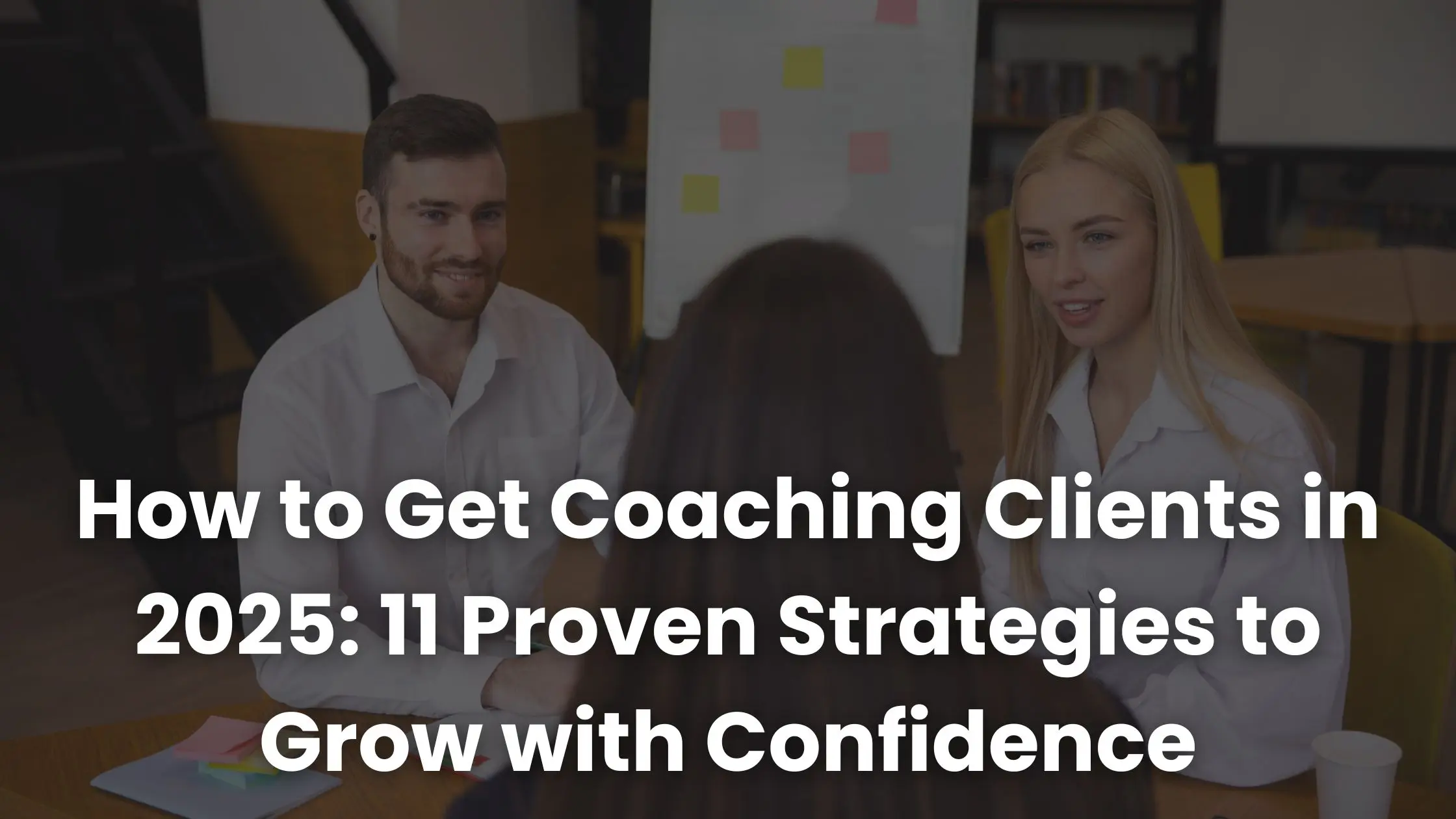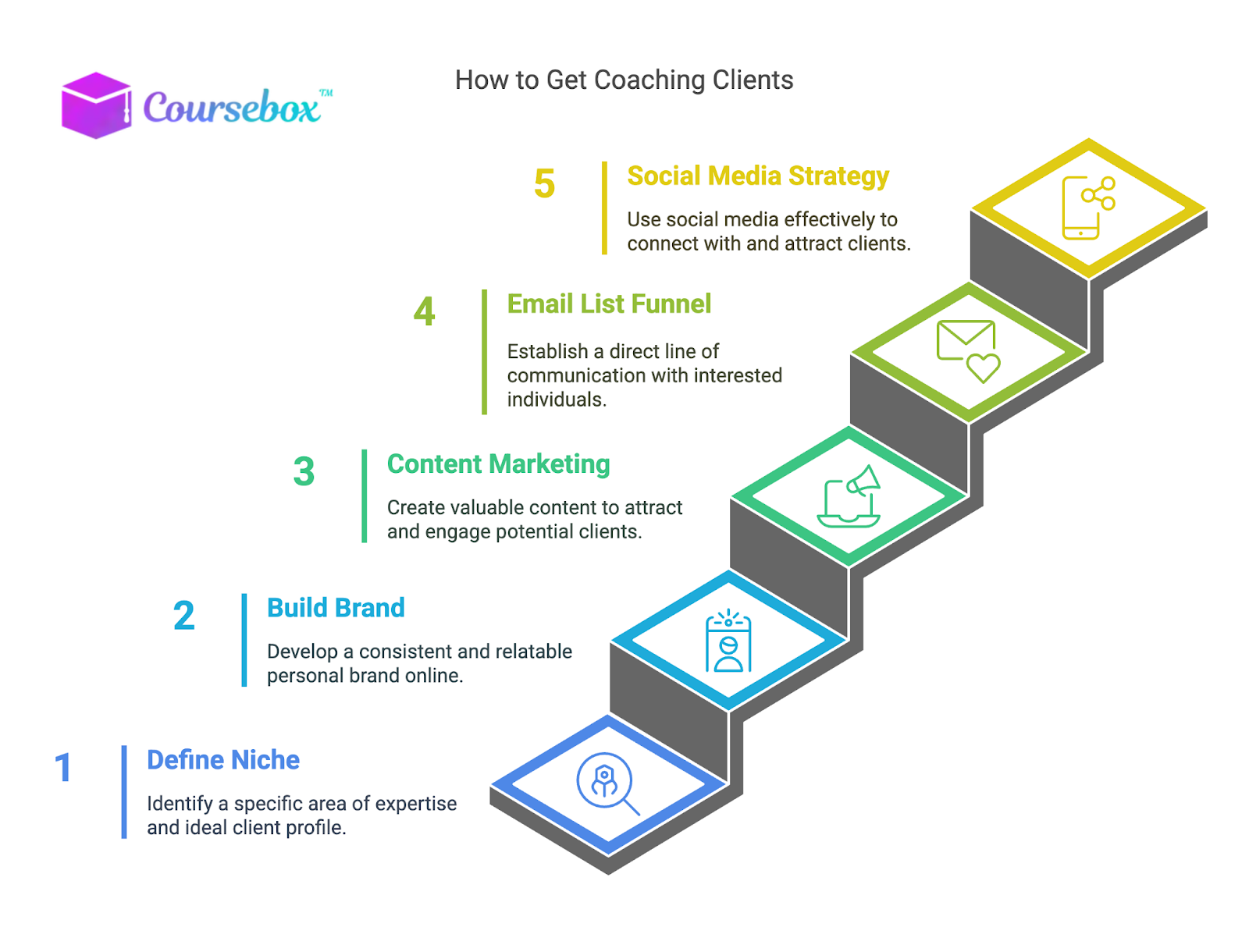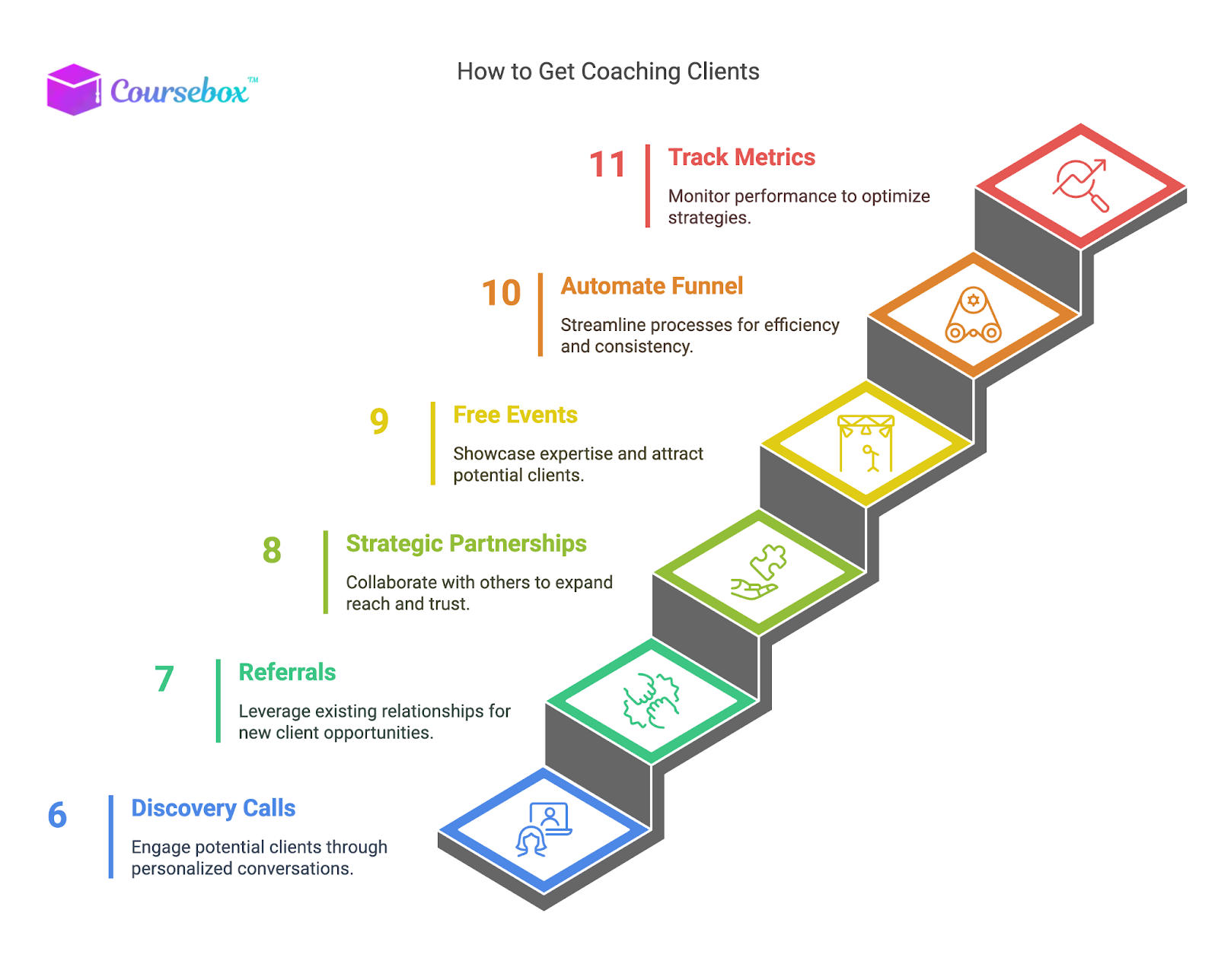How to Get Coaching Clients in 2025: 11 Proven Strategies to Grow with Confidence
Learn how to get coaching clients with strategies that actually work. From defining your niche to using referrals, content, and automation—this guide covers it all.
Learn how to get coaching clients with strategies that actually work. From defining your niche to using referrals, content, and automation—this guide covers it all.

Getting clients for your coaching business can be one of the most challenging (and frustrating) parts of building a sustainable practice.
Whether you’re just starting out or ready to scale, attracting high-quality clients isn’t about chasing—it’s about building trust and visibility in the right places.
In 2025, the global coaching industry is expected to reach $7.31 billion, more than doubling in size since 2019 (Source)—meaning more opportunity, but also more competition.

What worked even two years ago might not be enough now.
This guide breaks down the most effective, up-to-date methods to get coaching clients—from refining your niche to using email, SEO, and partnerships. Let’s walk through each step so you can confidently grow a thriving coaching business.

If you’re trying to coach “everyone,” you’ll probably end up helping no one. That’s why generalist coaches often struggle—they blend in and their message doesn’t stand out. People are looking for someone who understands their specific problem.
Your coaching niche is the area where your skills, personal story, and client needs all come together. It could be career transitions, burnout recovery, or emotional wellness. Pick something that feels aligned and specific.
Once you’ve defined your niche, create your Ideal Client Avatar (ICA). This is a made-up profile of your dream client. Think about:
Use their actual words when describing their struggles. If they say, “I’m stuck and tired of spinning my wheels,” don’t reword it—use it.
Finally, make sure your offer connects to a real outcome they care about. People don’t just want coaching—they want results they can feel and see. When your message lines up with what they’re already looking for, you’ll naturally attract the right people.
Your personal brand is how people see and remember you online. It's more than a logo or color palette—it’s your voice, message, and the way you show up. And in a crowded space, your brand helps people decide if you’re the right coach for them.
Start by positioning yourself as a helpful guide, not a “guru.” People want someone relatable who understands their struggles and can walk alongside them—not above them.
Keep your messaging consistent. That means the way you talk about your work should feel the same across your website, Instagram bio, email signature, and even your LinkedIn headline.
Choose a brand voice that fits your audience. For example, if you coach burnt-out professionals, your tone might be calm and steady. If you work with creatives, it might be more playful.
Use quality visuals to support your message:
Don’t be afraid to show real client progress. It builds trust and shows people what’s possible when they work with you. A strong personal brand makes you memorable—and trusted.
Content marketing helps people find you, trust you, and learn from you—before they ever talk to you. That’s why it often works better than sending cold DMs. Cold messages feel random. But good content builds real connection over time.
Start by picking the right platform. Choose one that feels natural to you and where your audience already hangs out. That could be:
Focus on creating evergreen content—posts or videos that stay useful for months or years. Answer questions your ideal clients are already searching for. Think “how-to,” “mistakes to avoid,” or “what I wish I knew.”
Add some SEO basics to help your content get found. Use clear titles with keywords, short meta descriptions, and internal links to related topics.
Once you’ve made a piece of content, repurpose it. Turn a blog post into an Instagram caption. Use podcast quotes in an email. Share one idea in multiple formats to reach more people with less effort.
Over time, your content becomes a quiet engine that brings leads to you—without chasing.
An email list gives you a direct line to people who want to hear from you. Social media can change overnight—but your list is something you own. The key is to start simple and make it worth their while.
Offer a lead magnet your ideal client actually wants. That could be:
Place opt-in forms in the right spots—like your homepage, blog posts, or pop-ups. Make the form short and clear. Just asking for a name and email is often enough.
Once someone joins your list, send a welcome sequence. This is a set of 3–5 emails that share who you are, what you offer, and how you can help. It builds trust from the beginning.
After that, send regular emails—once a week is plenty. Share tips, case studies, or short personal stories that connect to your work.
As your list grows, segment it. This means sending different messages to different groups based on what they signed up for or where they are in their journey. More relevance = more engagement.
Social media can be a great way to connect with future clients—but it doesn’t have to take over your life. The key is to be intentional.
Start by choosing 1–2 platforms where your audience already spends time. For some coaches, that’s Instagram. For others, it might be LinkedIn or YouTube. You don’t need to be everywhere to be effective.
Create a mix of content to keep things interesting and helpful:
Use features like Reels, Lives, and carousels to reach more people—these tools get more visibility on most platforms.
When people comment or message you, reply like you would to a friend. Keep it real. You’re not trying to sell—you’re building trust.
In your posts, add soft calls-to-action like, “DM me if you want support” or “Save this for later.” These simple prompts help guide people without pressure.
Social media doesn’t have to feel like a full-time job. With the right focus and a clear message, a few good posts a week can go a long way.

Discovery calls are short, one-on-one chats where you and a potential client see if working together makes sense. They work best when the lead is already somewhat interested—what marketers call a “warm lead.”
Start by inviting the right people. You can use a phrase like, “If this sounds like you, book a free call.” Keep it low-pressure. It’s a conversation, not a sales pitch.
Before the call, ask them to fill out a quick form or quiz. This helps you know if they’re a good fit and saves time.
During the call, follow a simple structure:
Focus more on their story than your offer. When people feel heard, they’re more likely to trust your support.
After the call, send a short follow-up email. Summarize what you talked about and outline the next step—like scheduling the first session or reviewing a proposal.
When done well, discovery calls feel like help, not pressure. They’re a chance to connect, offer value, and see if you’re the right coach for them.
Referrals are one of the easiest and most trusted ways to find new coaching clients. People tend to trust recommendations from someone they already know. And the best time to ask is when a client finishes working with you and feels good about their results.
You don’t need to make it a big deal. Just say something like, “If you know anyone who could use support like this, feel free to send them my way.”
To encourage more referrals, offer a simple thank-you gift. This could be:
Make it easy for people to share. Provide a short message they can copy and paste into a text or email. If you use referral links or forms, keep them simple and direct.
You can also team up with other service providers who work with the same type of client—like therapists, consultants, or nutritionists. These partnerships can lead to steady referrals over time.
The key is to make it feel natural, not transactional. When clients believe in what you do, they’ll want to tell others. All you have to do is ask—and make it easy to follow through.
You don’t have to grow your coaching business alone. Working with others can help you reach new people, build trust faster, and open doors that are hard to open by yourself. That’s where partnerships and collaborations come in.
Start by joining mastermind groups or online communities where coaches connect and support each other. These spaces are great for sharing ideas, learning what’s working, and meeting future collaborators.
Look for ways to co-host events with people who serve a similar audience. These could be:
You can also grow your reach by being a guest on podcasts or YouTube channels in your niche. Choose ones your ideal clients already listen to or watch.
Finally, reach out to course creators, authors, or influencers that your audience follows. Suggest a way to create value together—like a live Q&A, a giveaway, or a joint post.
Partnerships work best when both sides win. Keep it simple, clear, and focused on helping the audience. When you show up and collaborate with purpose, you build trust with people who might never have found you on their own.
Free events are a low-pressure way to let people experience your coaching style. When done well, they help you build trust, offer real value, and invite the right people to take the next step.
You can host a short webinar or mini-workshop—about 30 to 60 minutes. Pick a topic that solves one small but specific problem your ideal client is facing. This keeps the session focused and useful.
To make it more engaging, add a simple workbook or action guide. This helps people stay involved and gives them something to refer back to after.
Here are some ideas for your event:
At the end, share a soft pitch. Let them know how they can go further with your help. This could be booking a call, joining a group, or reading more on your site.
You don’t need to push. Just guide them to the next step if it feels like a good fit. Over time, these free events can become one of your best tools for building real relationships.
Once your content and lead magnets are working, it's time to make things easier with automation. A client funnel is the step-by-step path people take from finding you to working with you. Automating parts of that process saves time and helps you stay consistent.
Start with tools that fit your needs. For example, if you want an all-in-one platform that handles funnels, lead magnets, landing pages, and course delivery, Coursebox.ai is a simple option made for coaches.
It helps you build your funnel, automate emails, and even create digital coaching products in one place—so you spend less time on tech and more time helping clients.

And you can also try:
Set up a simple system to guide people through your funnel. That might look like this: visit your website → download a free resource → get a welcome email → book a call → become a client.
Track how each step performs. Look at things like landing page views, email open rates, and discovery call conversions. This helps you see what’s working and what’s not.
Ask clients what drew them in. Use that feedback to update your copy, offers, or content. Even small changes can make a big difference.
Also, test different CTAs (calls-to-action). Try phrases like “Let’s talk” or “Get support” to see what gets more clicks.
The goal is to create a smooth, helpful experience that works even when you’re offline. When your funnel is clear and efficient, it becomes easier to grow without burnout.
Staying consistent is one of the most important parts of growing your coaching business. It’s not about big moves—it’s about showing up regularly and adjusting along the way.
Each month, take a little time to review what’s working. Look at your traffic, email signups, booked calls, and sales. These are called “conversion metrics,” and they show you what’s leading to results.
Make note of the content or platforms that bring in the most leads. That might be one blog post, a Reels format, or a certain podcast episode.
Once you know what’s working, do more of that. And don’t be afraid to pause or drop what’s not helping.
Here are a few things to check:
Ask your clients directly how they found you. Then, use that info to improve that channel even more.
Marketing works best when you treat it like a long-term relationship. Keep showing up, listen to what’s working, and trust that steady effort will lead to steady growth.
You don’t need to be everywhere or do everything to get coaching clients—you just need a few focused strategies that work well for your audience. From defining your niche and sharing consistent content to using referrals and building systems, every step you take compounds over time.
Clients are already searching for support. When your message is clear, your offer is strong, and your presence is intentional—you’ll be the coach they choose.
👉 Now it’s your turn. Pick one strategy from this list and start today!
